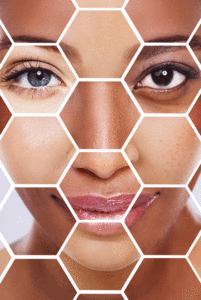Have you heard about your skin type and skin color referred to as a number, like type 2 or 3? This number refers to your skin on the Fitzpatrick Skin Type Scale.
This scale measures how skin reacts to sun exposure.
It’s an extremely useful skin measuring tool to consider since skin can react differently to skin treatments depending on the person’s Fitzpatrick skin type.
Many clinicians use this scale as a guide to measure how deeply they can do chemical peels, and the ideal lasers for skin colors.

In some skin care lines, there may be products not suitable for the darker Fitzpatrick skin types.
The table below represents some examples of the Fitzpatrick scale.
These are generalizations, so your clinician will need to do a more detailed assessment. This is necessary as many persons come from mixed origins.
| Skin Type | Skin Color | Hair & Eye Color | Reaction to Sun | Ethnicity |
| Type I | White | Blonde hair, green eyes | Always burns, freckles, never tans | English, Scottish |
| Type II | White | Blonde hair, green, hazel or blue eyes | Always burn, freckles, tans minimally | Northern European |
| Type III | White | Blonde or brown hair, blue or brown eyes | Tans after several burns, may freckle | German |
| Type IV | Brown | Brown hair, brown eyes | Tans more than average, rarely burns. | Mediterranean, Southern European, Hispanic |
| Type V | Dark Brown | Brown or black hair, brown eyes | Tans with ease, rarely burns | Asian, Indian, some Africans |
| Type VI | Very Dark Brown | Black hair, brown or black eyes | Deeply pigmented, tans, never burns | Africans or Aboriginals |
The beauty of Melanopeel® is that it is a virtually color blind skin system
We have created a unique system that works remarkably well on all skin colors.








